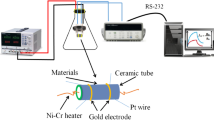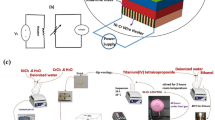Abstract
In this study, hydrothermal method was used to synthesized Ni-doped In2O3 microcubes. XRD, Raman, XPS, and UV–Vis spectroscopy were used to examine additional structural, chemical, morphological, and optical characteristics of In2O3 and Ni-doped In2O3. In addition, the gas sensing measurement of synthesized material was also carried out. It was observed that the Ni-In7 sensor responds to 1 ppm NO2 with the greatest sensor response (Rg/Ra=6.46) and fastest response/ recovery time (30/120s) at 120 °C operating temperature which is 6 times greater than the Ni-In0 sensor. Furthermore, Ni-In7 displayed good stability in addition to its outstanding selectivity towards NO2. A high oxygen vacancy concentration gives more electrons to enhance NO2 activation. Additionally, the incorporation of Ni into the In2O3 structure contributes to the material's large surface area.








Similar content being viewed by others
Data availability
The datasets generated during and/or analyzed during the current study are available from the corresponding author on reasonable request.
References
N. Elsayed, Toxicology 89, 161–174 (1994). https://doi.org/10.1016/0300-483X(94)90096-5
R.. J.. van der A et al., J. Geo. Phys. Res. Atmos (2008). https://doi.org/10.1029/2007JD009021
M. Modak et al., J. Mater. Sci. 33, 26205–26224 (2022). https://doi.org/10.1007/s10854-022-09306-2
D. Han et.al, Sens, Act. B 25, 1139–1146 (2018). https://doi.org/10.1016/j.snb.2017.08.083
S. Mahjan et al., Microelectronic. Eng. 266, 111887 (2022). https://doi.org/10.1016/j.mee.2022.111887
W.H. Organization, World Health Statistics 2016: Monitoring Health for the SDGs Sustainable Development Goals (World Health Organization, Geneva, 2016)
J.A. Bernstein et al., J. Allergy Clin. Immunol. 114(5), 1116–1123 (2004). https://doi.org/10.1016/j.jaci.2004.08.030
U. Choudhari et al., AIP Adv. 11(12), 125327 (2021). https://doi.org/10.1063/5.0072691
A. Mirzaei et al., Ceram. Int. 42, 15119–15141 (2016). https://doi.org/10.1016/j.ceramint.2016.06.145
S. Zhao et al., Sens. Act. B 282, 917–926 (2019). https://doi.org/10.1016/j.snb.2018.11.142
J. Cao, Research 2021 (2021). https://doi.org/10.34133/2021/9863038
S. Mahajan et al., J. Elec. Mater. 50, 2531–2555 (2021). https://doi.org/10.1007/s11664-021-08761-7
N. Yamazoe et al., Sens. Act. B 138(1), 100–107 (2009). https://doi.org/10.1016/j.snb.2009.01.023
S. Mahajan et al., Appl. Mater. Today 18, 100483 (2020). https://doi.org/10.1016/j.apmt.2019.100483
Z. Zhu et al., Appl. Surf. Sci. 320, 348–355 (2014). https://doi.org/10.1016/j.apsusc.2014.09.108
Y. Zhao et al., Sens. Act. B 328, 129030 (2021). https://doi.org/10.1016/j.snb.2020.129030
Z. Li et al., J. Alloys Comp. 770, 721–731 (2019). https://doi.org/10.1016/j.jallcom.2018.08.188
Y. Liu et.al, Sens, Act. B 352(1), 131001 (2022). https://doi.org/10.1016/j.snb.2021.131001
J. Ma et al., Cera. Inter 45(7), 9225–9230 (2019). https://doi.org/10.1016/j.ceramint.2019.01.268
H. Zhang et al., RSC. Adv 7, 49273–49278 (2017). https://doi.org/10.1039/C7RA09397G
K.K. Pawar, J. Alloys Comp. 806, 726–736 (2019). https://doi.org/10.1016/j.jallcom.2019.07.248
M. Ding et.al, Sens, Act. B 252, 418–427 (2017). https://doi.org/10.1016/j.snb.2017.06.016
P. Li, RSC Adv. 4(29), 15161–15170 (2014). https://doi.org/10.1039/c3ra47467d
Q. Yang Sens, Act. B 241, 806–813 (2017). https://doi.org/10.1016/j.snb.2016.09.145
D. Han Sens, Act. B chem. 216, 488–496 (2015). https://doi.org/10.1016/j.snb.2015.04.083
Z. Wang et al., ACS. Sens. 3, 468–475 (2018). https://doi.org/10.1021/acssensors.7b00896
J. Ri et al., Sens. Act. B 317, 128194 (2020). https://doi.org/10.1016/j.snb.2020.128194
Z. Ma et al., Sens. Act. B Chem. 305, 127377 (2020). https://doi.org/10.1016/j.snb.2019.127377
C. Zhao et al., Sens. Act. B Chem. 207, 313–320 (2015). https://doi.org/10.1016/j.snb.2014.10.087
C. Zhao et al., Sens. Act. B chem. (2015). https://doi.org/10.1016/j.snb.2019.126946
Z. Wang et al., Nanoscale 8, 10622–10631 (2016). https://doi.org/10.1039/C6NR00858E
V.D. Kapse et al., Vacuum 83(2), 346–352 (2008). https://doi.org/10.1016/j.vacuum.2008.05.027
Y. Chen et al., J. alloys comp. 581, 653–658 (2013). https://doi.org/10.1016/j.jallcom.2013.07.168
Z. Dong, Sens. Act. B chem. (2022), p.131227. https://doi.org/10.1016/j.snb.2021.131227
M. Modak et al., Cera. Inter 48, 19978–19989 (2022). https://doi.org/10.1016/j.ceramint.2022.03.273
Q. Yang et al., New J. Chem. 40, 2376–2382 (2013). https://doi.org/10.1039/C5NJ02325D
P. Bogdanov et al., Sens. Act. B Chem. 57(1–3), 153–158 (1999). https://doi.org/10.1016/S0925-4005(99)00157-4
X. Zhang et al., J. Mater. Chem. C 7, 7219–7229 (2019). https://doi.org/10.1039/C9TC00978G
M.J. Valero-Romeo et al., Chem. Eng. J. 360, 75–88 (2019). https://doi.org/10.1016/j.cej.2018.11.132
J. Bai et al., J. Colloid Inter. Sci. 560, 447–457 (2020). https://doi.org/10.1016/j.jcis.2019.10.090
H. Zhu, Crys et al., Growth. Des. 8, 950–956 (2008). https://doi.org/10.1021/cg700850e
A. Singhal et al., J. Phys. Chem. C 113, 3600–3606 (2009). https://doi.org/10.1021/jp8097846
H. Zhao et al., J. Mat. Chem. Phys. 130, 921–931 (2011). https://doi.org/10.1016/j.matchemphys.2011.08.013
H.M. Chen et al., Aip Adv. 4, 047121 (2014). https://doi.org/10.1063/1.4871937
X.L. Wang et al., Appl. Phys. Lett. 102, 102112 (2013). https://doi.org/10.1063/1.4795797
O. Bierwagen Semicond, Sci. Technol. 30, 024001 (2015). https://doi.org/10.1088/0268-1242/30/2/024001
W. Du et al., Ceram. Int. 46, 20385–20394 (2020). https://doi.org/10.1016/j.ceramint.2020.05.129
J. Gan et al., Sci. Rep. 3, 1021 (2013). https://doi.org/10.1038/srep01021
B. Li, Langmuir 22(22), 9380–9385 (2006). https://doi.org/10.1021/la061844k
Y. Liu et al., Elect. Acta 59, 121–127 (2012). https://doi.org/10.1016/j.electacta.2011.10.051
H.J. Kim et al., ACS Appl. Mater. Interfaces 6, 18197–18204 (2014). https://doi.org/10.1021/am5051923
S. Bai et al., J. Mater. Chem. A 1, 11335–11342 (2013). https://doi.org/10.1039/C3TA11516J
D. Han et al., Sens. Act. B Chem. 262(1), 655–663 (2018). https://doi.org/10.1016/j.snb.2018.02.052
C.W. Na, Sens. B. Chem. Act. (2018), pp.1671–1679. https://doi.org/10.1016/j.snb.2017.08.172
Y. Liu, J. Colloid Interface Sci. 541, 249–257 (2019). https://doi.org/10.1016/j.jcis.2019.01.052
K. Chen et al., Sens. Act. B 308(1), 127716 (2020). https://doi.org/10.1016/j.snb.2020.127716
H. Ma et al., J. Alloys Comp. 782, 1121–1126 (2019). https://doi.org/10.1016/j.jallcom.2018.12.180
D.A. Mirabella et al., Sens. Act. B Chem. 285, 232–239 (2019). https://doi.org/10.1016/j.snb.2019.01.024
N. Srinatha, RSC Adv. 6, 9779–9788 (2016). https://doi.org/10.1039/C5RA22795J
J. Zhang et al., RSC Phys. Chem. Phys. 19, 6313–6329 (2017). https://doi.org/10.1039/C6CP07799D
Acknowledgements
The authors would like to express their gratitude to Dr. Niranjan Ramgir at the technical physics division of the Bhabha Atomic Research centre in Mumbai, Maharashtra, India for XPS characterization. Also, the authors would like to thank Science and Engineering Research Board (SERB)’s core research grant (CRG/2019/004990) gave financial assistance for this project.
Author information
Authors and Affiliations
Contributions
SH: This study’s conceptualization, methodology, formal analysis, writing - first copy, and investigation. SJ: Project management, Conceptualization, Methodology, Supervision, Writing - Review and Editing.
Corresponding author
Ethics declarations
Conflict of interest
The author declares that there is no conflict of interest in this paper.
Ethical approval
This article does not contain any studies with human or animal subjects.
Additional information
Publisher’s note
Springer Nature remains neutral with regard to jurisdictional claims in published maps and institutional affiliations.
Rights and permissions
Springer Nature or its licensor (e.g. a society or other partner) holds exclusive rights to this article under a publishing agreement with the author(s) or other rightsholder(s); author self-archiving of the accepted manuscript version of this article is solely governed by the terms of such publishing agreement and applicable law.
About this article
Cite this article
Hambir, S., Jagtap, S. NO2 sensing behavior of Ni-doped In2O3 microcubes based chemiresistive gas sensors. J Mater Sci: Mater Electron 34, 1716 (2023). https://doi.org/10.1007/s10854-023-11147-6
Received:
Accepted:
Published:
DOI: https://doi.org/10.1007/s10854-023-11147-6




